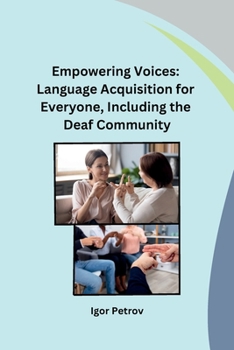Empowering Voices: Language Acquisition for Everyone, Including the Deaf Community
Hearing impairments, also known as hearing loss or deafness, are conditions that affect a person's ability to hear or understand sounds. It is important for everyone, including those in the field of language acquisition, to have a comprehensive understanding of hearing impairments and their impact on individuals' lives. This subchapter aims to provide a broad overview of hearing impairments, their causes, and various communication methods used by the deaf community.
Hearing impairments can be categorized into different types based on their severity and the affected part of the auditory system. Conductive hearing loss occurs when there is a problem in the outer or middle ear, which hinders sound transmission to the inner ear. Sensorineural hearing loss, on the other hand, results from damage to the inner ear or auditory nerve, making it difficult to perceive sound properly. Mixed hearing loss combines elements of both conductive and sensorineural hearing loss.
There are several factors that contribute to hearing impairments, including genetics, infections, exposure to loud noises, trauma, and certain medications. It is crucial to understand that hearing impairments are not solely physical conditions but can also have a significant impact on a person's linguistic and cognitive development. This is particularly relevant to language acquisition, as hearing impairments can affect a person's ability to acquire spoken language naturally.
To address the communication needs of individuals with hearing impairments, various methods have been developed. Sign language, such as American Sign Language (ASL), is a visual-gestural language that uses handshapes, facial expressions, and body movements to convey meaning. Sign language is a vibrant and rich language with its own grammar and syntax, and it is important to recognize it as a legitimate language in its own right.
Other communication methods include lip-reading, which involves visually interpreting the movement of the speaker's lips, and the use of assistive devices like hearing aids and cochlear implants. These devices amplify sound or directly stimulate the auditory nerve to enhance hearing.
Understanding hearing impairments is crucial for language acquisition professionals, as it allows them to develop inclusive and effective strategies to support individuals with hearing impairments in their language development journey. By recognizing the diversity within the deaf community and embracing various communication methods, we can empower individuals with hearing impairments to fully participate in language acquisition and foster a more inclusive society.





